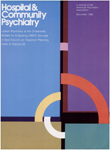Consultation-Liaison Psychiatry at the Crossroads: In Search of a Definition for the 1980s
Abstract
Consultation-liaison prychiatry did not emerge as a prominent psychiatric subspecialty until the remedicalization of the psychiatric profession in the 1970s. The author traces the history of consultation-liaison and discusses the various definitions of the subspecialty. He outlines how consultation-liaison psychiatrists work ingeneral hospitals and medical school departments of psychiatry. The future of consultation-liaison psychiatry, the author says, depends on developments in four areas: psychosomatic research, behavioral medicine, holistic health care, and general hospital psychiatty. To ensure a bright future for the subspecialty, consultation-liaison psychiatrists must meet fiscal, research, and political challenges, make peace with other behavioral scientists, develop close relations with the nursing profession, enjoy the support of medical school departments of psychiatty, and transform the consultation model into a comprehensive consultation-liaison model.
Access content
To read the fulltext, please use one of the options below to sign in or purchase access.- Personal login
- Institutional Login
- Sign in via OpenAthens
- Register for access
-
Please login/register if you wish to pair your device and check access availability.
Not a subscriber?
PsychiatryOnline subscription options offer access to the DSM-5 library, books, journals, CME, and patient resources. This all-in-one virtual library provides psychiatrists and mental health professionals with key resources for diagnosis, treatment, research, and professional development.
Need more help? PsychiatryOnline Customer Service may be reached by emailing [email protected] or by calling 800-368-5777 (in the U.S.) or 703-907-7322 (outside the U.S.).



